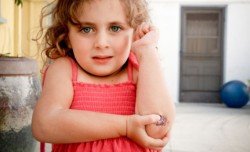It is often normal to see bruises in children, especially once they 
Causes of Bruises in Children
As part of children’s play time, actively moving around can cause direct blow to the skin leading the blood vessels to rupture and cause a purplish black spot on a child’s skin. The bruise will turn greenish-yellow as the blood seeps is reabsorbed by the body. Some of the most common causes of bruises in children include:
- Trips and falls
- Bumping into objects
- Accidental hits
- Child abuse
- Causes of abnormal bruising
- Low platelet count
- Low clotting factor
- Very weak skin
- Major trauma
When to Expect Bruises in Children
Multiple small bruises on the front of the legs are common in active children. Bruises also tend to show more in fair skinned children.
- Children who can independently walk
- Accident bruises tend to occur in the bony parts of the body, specifically the elbows and knees, usually in the front part
- Infants beginning to walk may have bruises in their forehead, nose, chin and back of the head
When to be concerned with Regard to Bruises in Children
Some children naturally bruise more easily as compared to other children in their age. However, there may be a need for concern when these factors are noticed in children with bruises:
- Unusual location of bruises including
- Face, specifically the eyes and mouth
- Back
- Back of the legs or calves
- Around the genitals
- Bruising in babies who are unable to crawl
- Abusive bruises are commonly found on the soft and covered parts of the body, such as the abdomen, back and buttocks
- Unexplainable bruises in the head, ear and neck
- Clusters of bruises often in the body or the limbs
- Sometimes, hand imprints occur
- Bruising to the scalp from hair being pulled violently
How to Treat Bruises in Children
Children with minor bruises can be treated at home, same way as how bruises in adults are treated. For disorders that result to bruising, pediatricians and hematologists determine the proper treatment for them. Children with not suspicious bruises can be treated by
- Resting the bruised area
- Ice packs should be applied for 15 minutes several times a day, especially in the first two days. Ice should be wrapped in cloth or towel and never directly in contact with the skin.
- Elevate the bruised area if possible.
These hints should not be used as medical advice or substitute as first aid training. Furthermore, excessive bruising in children may be a sign of a blood disorder or even child abuse. To learn how to recognize symptoms and treat bruises in children, enroll in first aid courses offered by workplace approved.
